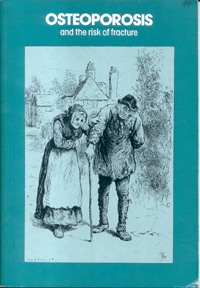Osteoporosis has been a long recognised disorder even if its causes have not. Research undertaken by Little (1973) found examples from as early as the sixth…
Osteoporosis has been a long recognised disorder even if its causes have not. Research undertaken by Little (1973) found examples from as early as the sixth century AD when Paulas Aeginata described a condition of the bone typical of osteoporosis. He also referred…
Osteoporosis has been a long recognised disorder even if its causes have not. Research undertaken by Little (1973) found examples from as early as the sixth century AD when Paulas Aeginata described a condition of the bone typical of osteoporosis. He also referred to non-healing hip fractures and vertebral ‘arthritis’ the result of a ‘weakness of the parts’. In 1824 Astley Cooper stated that in old age bones ‘become thin in their shell and spongy in the texture’, he also noted that fractures of the neck of femur (hip) often followed moderate trauma. Whilst many physicians, even before the discovery of the X-ray in 1895, were aware that the bones of the elderly often became thin and fragile (Gordon ct al, 1976) it was not until 1940 that osteoporosis was linked with the postmenopausal state (Fuller Albright et al, 1941).
Only in recent years has the scale of the problem of osteoporosis been recognised by health care professionals. This may in part be explained by the fact that osteoporosis and its related fractures are a multidisciplinary problem, that is it crosses several specialities in medicine including orthopaedics, geriatrics and gynaecology.
The most obvious manifestation of osteoporosis is a fracture, usually of the vertebrae, wrist or hip. Osteoporosis and its related fractures are an increasing health and economic problem and this booklet concentrates on the risks of osteoporotic fracture, the prevention of these fractures and the socio-economic costs of both fractures and preventive measures.
An increased life expectancy has led to a growing elderly population. As life expectancy has increased so have the diseases of elderly people, particularly women. Women are especially vulnerable to osteoporotic fractures not only because of the link between osteoporosis and the menopause but also because more women survive to the age at which osteoporotic fractures occur than men. It is projected that by 2031 the number of elderly people (over 65s) in the United Kingdom will be 13.6 million (22 per cent of the total population) as compared with 9.6 million (16 per cent of the total population) in 1987 (Annual Abstract of Statistics 1989). The growth in population of 4.3 million between the two years can almost entirely be accounted for by an increase in the numbers of the elderly.
The result of this increase in population in terms of the number of hip fractures (the most expensive osteoporotic fracture) occurring can be seen in Figure 1. Even on the conservative estimate that the discharge rate does not increase (there will in fact be a shift towards a more elderly population) it is estimated that the number of hip fractures in England and Wales will be 50,581 an increase of 17 per cent (7,351). The true figure may be much higher. Without therapeutic and prophylactic intervention. the economic and social costs of osteoporosis will continue to rise in the years ahead.
